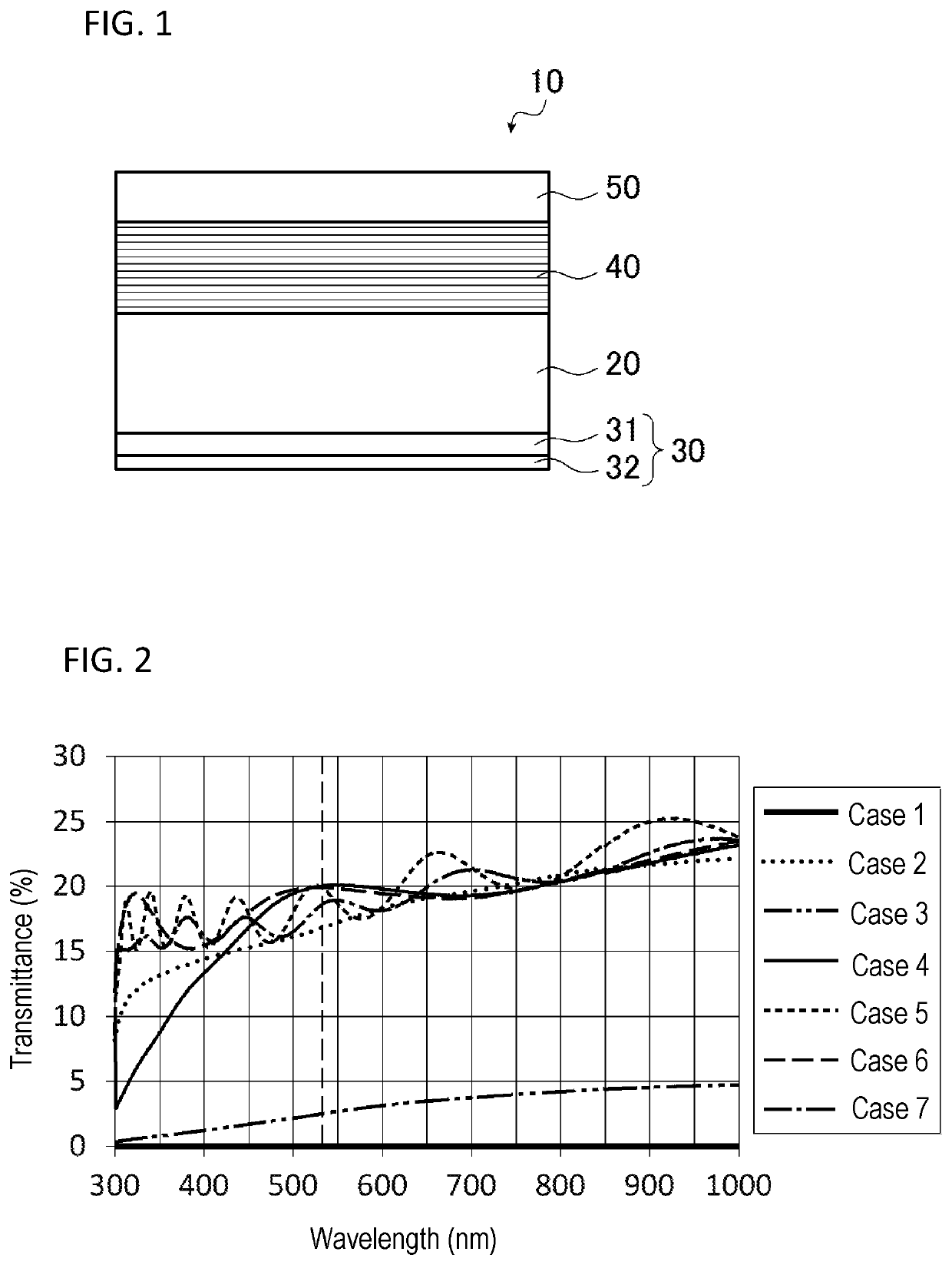Reflective mask blank and reflective mask
a mask and reflective technology, applied in the field of reflective masks and mask blanks, can solve the problems of dielectric breakdown, the limit of a conventional photolithography method has been approached, and the semiconductor device processing is accelerating, so as to avoid the deformation of the substrate caused by stress, improve the position deviation of a pattern during transfer, and ensure the effect of a sufficient holding for
- Summary
- Abstract
- Description
- Claims
- Application Information
AI Technical Summary
Benefits of technology
Problems solved by technology
Method used
Image
Examples
case 1
(Case 1)
[0128]In this Case 1, the conductive layer 32 was formed without forming the stress compensation layer 31 on one surface side of the substrate 20.
[0129]A SiO2—TiO2 based glass substrate (6 inches (about 152 mm) square in outer dimensions, and 6.3 mm thick) was used as the substrate 20 for the deposition. The glass substrate has a coefficient of thermal expansion of 0.05×10−7 / ° C. at 20° C., a Young's modulus of 67 GPa, a Poisson's ratio of 0.17, and a specific rigidity of 3.07×107 m2 / s2. The glass substrate is polished to form a smooth surface with a surface roughness (rms) of 0.15 nm or less and flatness of 100 nm or less.
[0130]A CrN film was formed as a conductive layer 32 on one surface side of the substrate 20 by use of a magnetron sputtering method. The deposition conditions for the conductive layer 32 (CrN film) are as follows.
[0131]Target: Cr target
[0132]Sputtering Gas: mixed gas of Ar and N2 (gas flow (Ar / N2): 21 / 20 (sccm), gas pressure: 0.23 Pa)
[0133]Input Power: 1,...
case 2
(Case 2)
[0163]A CrO film was formed as the stress compensation layer 31 on one surface side of the substrate 20 by use of a magnetron sputtering method. The deposition conditions for the stress compensation layer 31 (CrO film) are as follows.
[0164]Target: Cr target
[0165]Sputtering Gas: mixed gas of Ar and O2 (gas flow (Ar / O2): 35 / 20 (sccm), gas pressure: 0.3 Pa)
[0166]Input Power: 700 W
[0167]Deposition Rate: 0.101 nm / sec
[0168]Film Thickness: 14 nm
[0169]Next, a CrN film was formed as the conductive layer 32 on the stress compensation layer 31 by use of the magnetron sputtering method, thereby forming the backside conductive film 30. The deposition conditions for the conductive layer 32 (CrN film) are as follows.
[0170]Target: Cr target
[0171]Sputtering Gas: mixed gas of Ar and N2 (gas flow (Ar / N2): 30 / 10 (sccm), gas pressure: 0.23 Pa)
[0172]Input Power: 700 W
[0173]Deposition Rate: 0.065 nm / sec
[0174]Film Thickness: 14 nm
[0175]The stress compensation layer 31 and the backside conductive fi...
case 3
(Case 3)
[0177]The backside conductive film 30 was formed by performing the same procedures as in the Case 2 except that the thickness of the stress compensation layer 31 (CrO film) was 30 nm and the thickness of the conductive layer 32 (CrN film) was 40 nm.
[0178]The stress compensation layer 31 and the backside conductive film 30 in the Case 3 were evaluated in the same procedures as in the Case 1, and the results were shown in Table 1 and Table 2.
[0179]As a result of the flatness of the reflective mask blank obtained in the same procedures as in the Case 1, the flatness was 1,110 nm and the reflective mask blank had a convex shape on the side where the reflective layer was formed.
PUM
| Property | Measurement | Unit |
|---|---|---|
| thickness | aaaaa | aaaaa |
| thickness | aaaaa | aaaaa |
| thickness | aaaaa | aaaaa |
Abstract
Description
Claims
Application Information
 Login to View More
Login to View More - R&D
- Intellectual Property
- Life Sciences
- Materials
- Tech Scout
- Unparalleled Data Quality
- Higher Quality Content
- 60% Fewer Hallucinations
Browse by: Latest US Patents, China's latest patents, Technical Efficacy Thesaurus, Application Domain, Technology Topic, Popular Technical Reports.
© 2025 PatSnap. All rights reserved.Legal|Privacy policy|Modern Slavery Act Transparency Statement|Sitemap|About US| Contact US: help@patsnap.com

